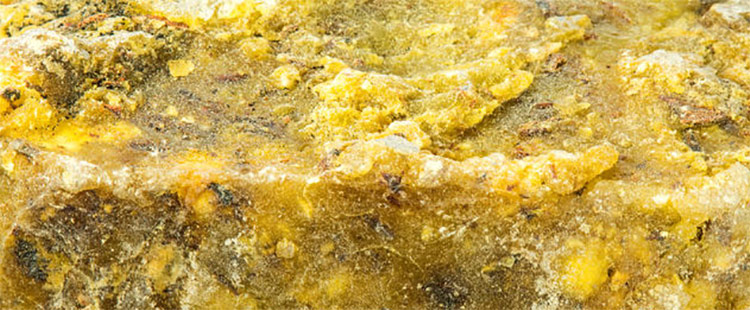Elemi Essential Oil
Canarium luzonicum / Canarium vulgare

Description
Elemi Essential Oil is distilled from the resin of the Asian tree Canarium luzonicum. As distilled oils derived from resins, Elemi and Frankincense oils share some similarities. Like Frankincense Essential Oil, Elemi Oil is rich in monoterpenes. It can be especially helpful in wound care and for supporting respiratory health. See the Uses section below for more possible applications. However, unlike Frankincense Essential Oil, Elemi Oil may contain methyl eugenol (a phenylpropanoid ether). See the Safety Information section below for dermal limit recommendations.

Elemi Essential Oil Benefits and Uses
- Respiratory Tract Infections
- Chronic Coughs
- Catarrh
- Stress-Related Bronchial Conditions
- Muscular Fatigue
- Infectious Skin Conditions
- Wounds
- Cuts
- Fatigue
Source: Valerie Ann Worwood, The Complete Book of Essential Oils and Aromatherapy, 25th Anniversary Edition (Novato, CA: New World Library, 2016, 584.
Botanical Name
Canarium luzonicum / Canarium vulgare
Plant Family
Common Method of Extraction
Distillation
Plant Part Typically Used
Color
Clear with a Tinge of Yellow
Consistency
Thin
Perfumery Note
Middle
Strength of Initial Aroma
Medium
Aromatic Description
Elemi Essential Oil smells fresh, resinous, citrusy, peppery and somewhat spicy.
Sustainability and Conservation Status
Vulnerable
Source: https://www.iucnredlist.org/species/33352/9779122
To learn more about the conservation status of essential oil bearing plants and how to use the IUCN Red List of Threatened Species, please refer to AromaWeb's Guide to Essential Oils and Sustainability.
Major Constituents
- (+)-Limonene
- Elemol
- a-Phellandrene
- Elemicin
- p-Cymene
- a-Pinene
- 1,8-Cineole
See Essential Oil Safety for a more complete list of typical constituents.
Source: B.M. Lawrence, Essential Oils 1979-1980 (Wheaton: Allured Publishing, 1981), 26-27. B.M. Lawrence, Essential Oils 1981-1987 (Wheaton: Allured Publishing, 1989), 109-110. B.M. Lawrence, Progress in Essential Oils. (Perfumer & Flavorist 28, 2003), 84-86. Sources cited in Robert Tisserand and Rodney Young, Essential Oil Safety (Second Edition. United Kingdom: Churchill Livingstone Elsevier, 2014), 272.
Elemi Essential Oil Safety Information
Tisserand and Young state that Elemi Oil may contain methyl eugenol, a phenylpropanoid ether. Their dermal maximum recommendation based on the possibility of 0.3% methyl eugenol content is 6.7%. They warn about avoiding use of the oil altogether if it has oxidized. Reading Tisserand and Young's full profile is recommended. [Robert Tisserand and Rodney Young, Essential Oil Safety (Second Edition. United Kingdom: Churchill Livingstone Elsevier, 2014), 272.]
Elemi CO2 Supercritical Select Extract
In addition to being available as an essential oil, this botanical is available from a small number of reputable sources as a CO2 extract. CO2 extracts offer many advantages. However, they can have differing safety precautions than essential oils because the natural chemistry of CO2 extracts can differ from their essential oil counterparts. Not much safety information is documented from trusted sources for CO2 extracts. Use CO2 extracts with great care and do not assume that every CO2 extract has the same safety precautions as its essential oil counterpart.
General Safety Information
Do not take any oils internally and do not apply undiluted essential oils, absolutes, CO2s or other concentrated essences onto the skin without advanced essential oil knowledge or consultation from a qualified aromatherapy practitioner. For general dilution information, read AromaWeb's Guide to Diluting Essential Oils. If you are pregnant, epileptic, have liver damage, have cancer, or have any other medical problem, use oils only under the proper guidance of a qualified aromatherapy practitioner. Use extreme caution when using oils with children and be sure to first read the recommended dilution ratios for children. Consult a qualified aromatherapy practitioner before using oils with children, the elderly, if you have medical issues or are taking medications. Before using this or any essential oil, carefully read AromaWeb's Essential Oil Safety Information page. For in-depth information on oil safety issues, read Essential Oil Safety by Robert Tisserand and Rodney Young.
Shelf Life
Important Information About the Profiles
The essential oil information provided on AromaWeb is intended for basic educational purposes only. The references to safety information, test results, constituents and percentages is generalized information. Essential oils can vary greatly in composition. The data is not necessary complete and is not guaranteed to be accurate. The essential oil photos are intended to represent the typical and approximate color of each essential oil. However, essential oil composition and color can vary based on harvesting, distillation, age of the essential oil and other factors. Profiles for several CO2 Extracts and absolutes are included within the directory, and are denoted as such.
